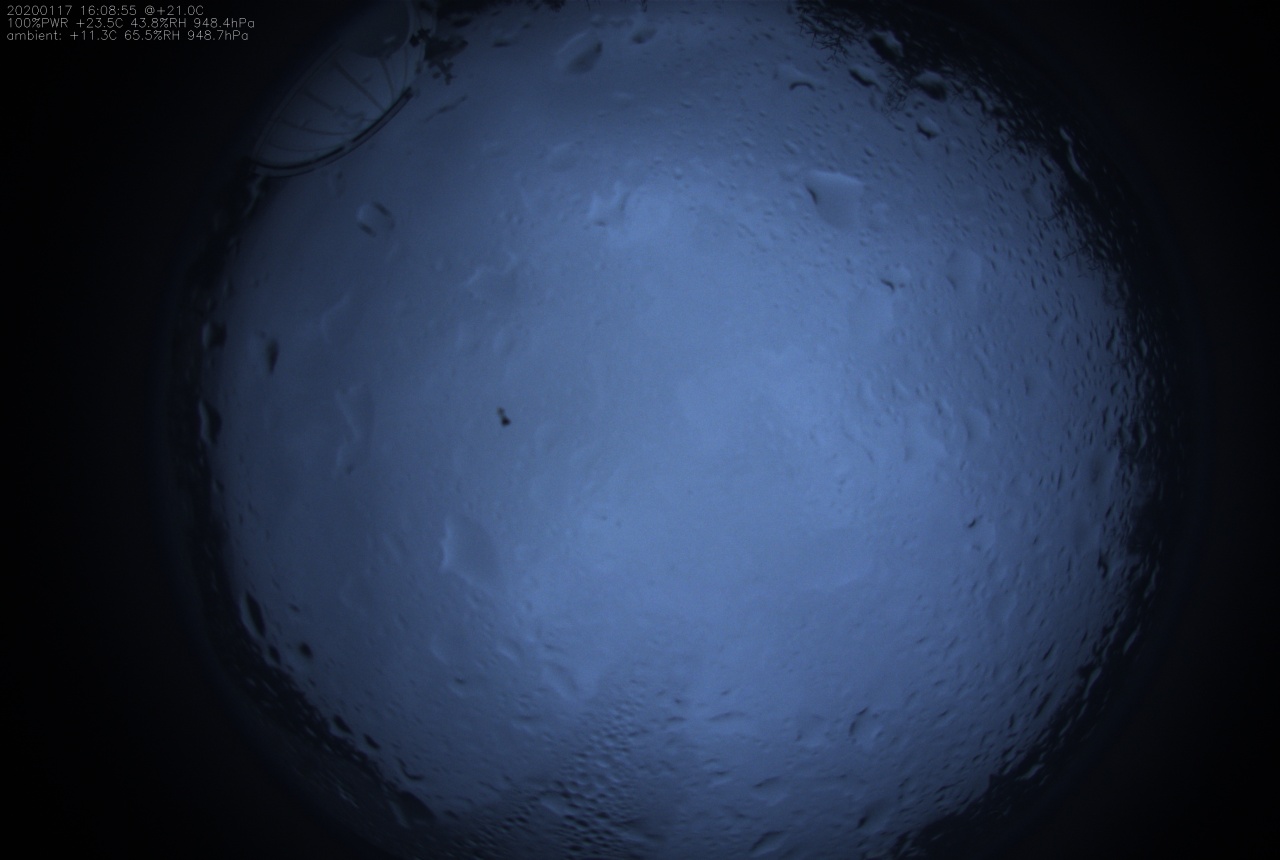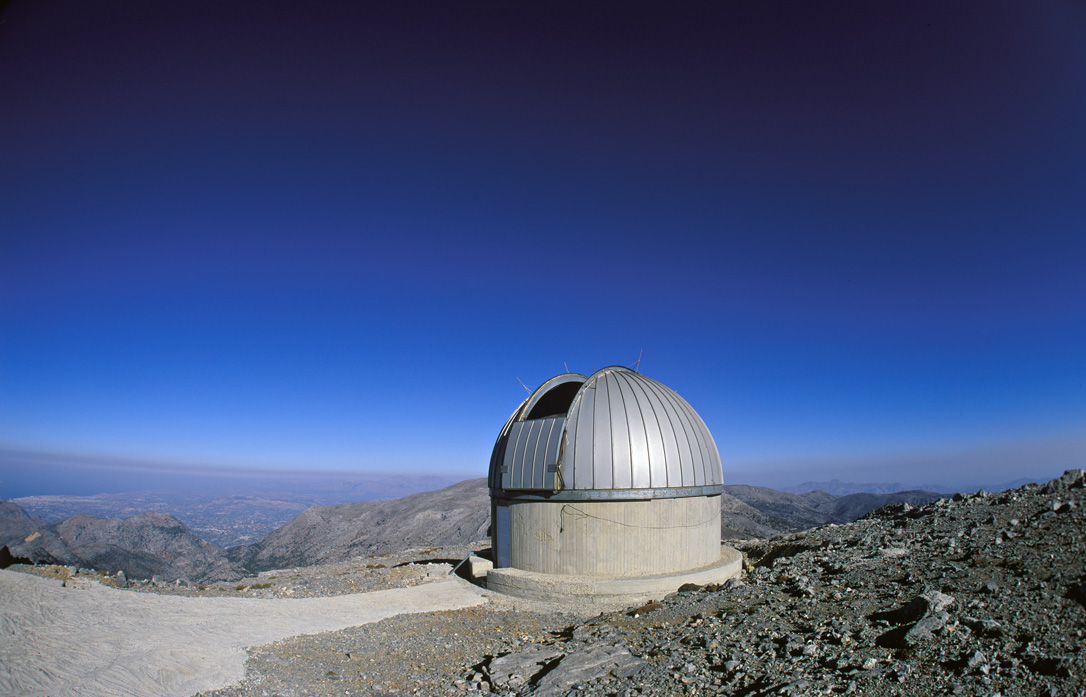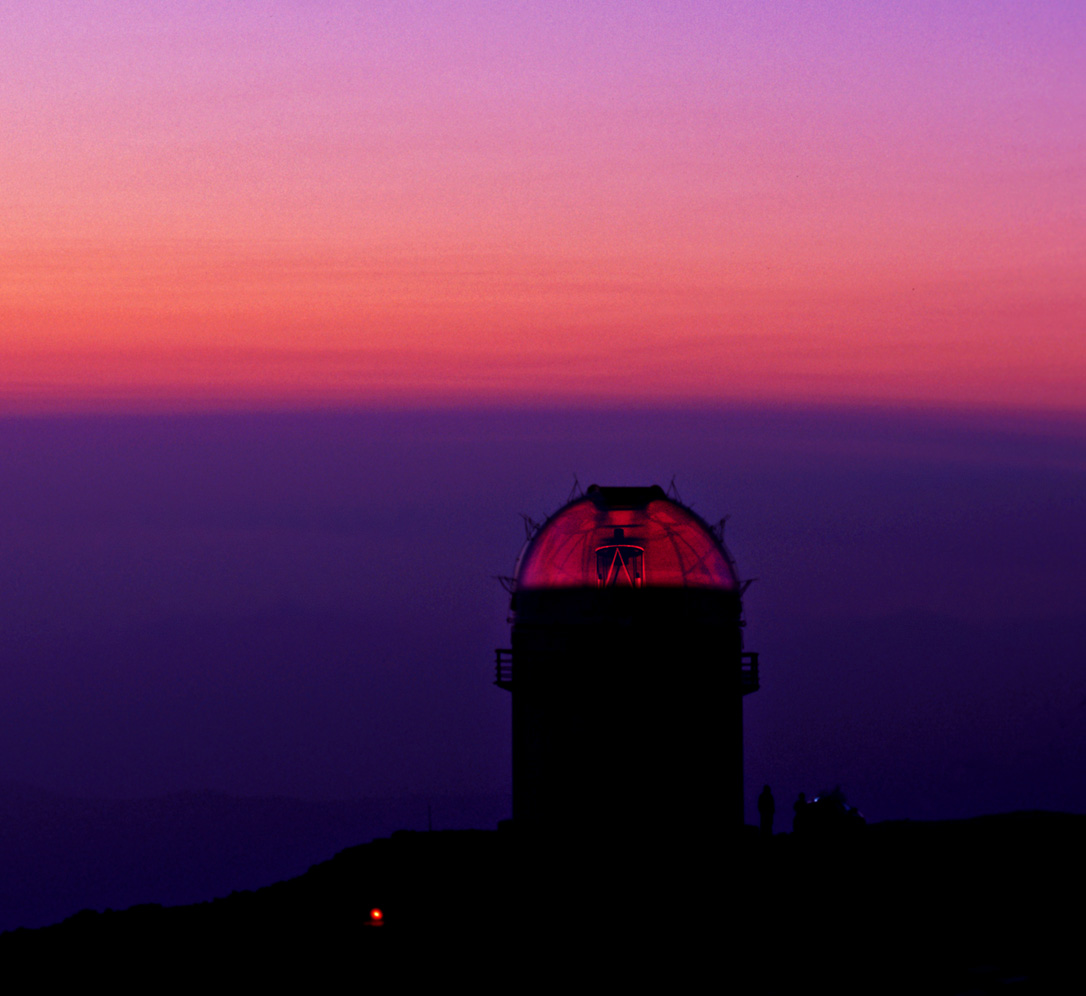
The Observatory / Die Sternwarte

Location / Standort
After its move from Namibia the Capella Observatory (the "old" observatory page can be found here) is located about 25 km south west to Heraklion/Crete (Greece), nearly 1750 m above sea on top of Mount Skinakas.
Das Capella-Observatory befindet sich nach seiner Verlegung aus Namibia (die Beschreibung des "alten" Observatoriums ist weiterhin hier zu finden) 25 km Luftlinie südwestlich von Heraklion/Insel Kreta (Griechenland) in knapp 1750 m Höhe auf dem Gipfel des Mount Skinakas.
Some kilometers away in direction Psiloritis (the highest mountain on Crete, 2456 m ASL) the Idäic Grotto, the legendary place, at which Zeus (Jupiter) was lactated by the goat Amalthea and where he hid from his father Chronos (Saturn) is located.
Wenige Kilometer weiter in Richtung des Psiloritis, des mit 2456 m höchsten Berges Kretas, liegt die Idäische Grotte, der sagenhafte Ort, an dem sich Zeus (Jupiter) nach seiner Geburt gesäugt von der Ziege Amalthea vor seinem Vater Chronos (Saturn) versteckt hielt.
The nearness to Heraklion results in an illuminated sky in north east direction, but all other directions show no or nearly no light pollution. The situation looking south can be seen in the following video: AVI-File (Div-Codec needed, file size is 2.2 MByte)
Die Nähe zu Heraklion hat zwar einen in Richtung Nordosten aufgehellten Himmel zur Folge, alle anderen Himmelsrichtungen zeigen aber kaum oder keine Lichtverschmutzung. Die Situation nach Süden demonstriert der folgende Film: AVI-Datei (DivX-Codec erforderlich, 2.2 MByte lang).
First imaging runs during August 2006 resulted in a seeing of about one arc second for hours, which is so important for astro photography with long focal lengths.
Erste Aufnahmen während einer Woche im August 2006 ergaben bei dem für die langbrennweitige Astrofotografie so wichtigen Seeing Werte von ca. einer Bogensekunde während stundenlanger Belichtungsreihen.
Because of heavy thunderstorms, freezing rain and snow the observatory is closed regulary from middle of November until end of March. During these months it is only accessible on foot.
Wegen schwerer
Gewitter, Eisregen und Schnee wird die Sternwarte regelmäßig von Mitte
November bis Ende März still gelegt – sie ist dann über Monate nur noch zu
Fuß zu erreichen.
The Coordinates / Die Koordinaten des Standortes:
Longitude 24°53´57" East, Latitude 35°12´43" North
The telescope "Ganymed" has guest status at the area of the Skinakas Observatory, which is the observatory of the Astronomical Institute of the University of Crete. The main instrument of the observatory - a modified RC-Telescope with 1.29m diameter - is located in immediate vicinity under a white dome. This telescope is the second largest in Greece. Detailed informations on the Skinakas observatory can be found at its home page.
Das Teleskop “Ganymed“ ist Gast auf dem Gelände des Skinakas Observatory, der Sternwarte des Astronomischen Instituts der Universität von Kreta. In unmittelbarer Nachbarschaft befindet sich das Hauptinstrument des Instituts, ein modifiziertes RC-Teleskop mit 1,29m Durchmesser unter einer weißen Kuppel. Dieses Teleskop ist das zweitgrößte in Griechenland. Nähere Informationen zum Skinakas Observatorium, seinen Instrumenten und Forschungsvorhaben finden Sie hier.
The basis for the stay at the observatory is a cooperation between the University of Crete (Prof. J. Papamastorakis) and the University of Tübingen (Prof. H. Ruder). A comfortable guest house is also located at this place where the guests do self-supply. The observatory is equipped with a fast internet access, which makes possible not only the control of the telescope but also the transfer of big image files. This will be the basis of a future robotic control of "Ganymed".
Grundlage unseres Aufenthalts dort ist ein Kooperationsvertrag zwischen der Universität Kreta (Prof. J. Papamastorakis) und der Universität Tübingen (Prof. H. Ruder). Der Standort bietet ein großzügiges Gästehaus für die Astronomen auf dem Berg. Die Verpflegung erfolgt im Modus der Selbstversorgung. Die Sternwarte ist mit einem sehr schnellen Internetanschluss ausgestattet, der nicht nur die Teleskopsteuerung sondern problemlos auch die Übertragung großer Bilddateien meistert. Das soll uns in naher Zukunft die Fernsteuerung von “Ganymed“ ermöglichen. |
|
The Dome /
Kuppelgebäude After shipping from Namibia "Ganymed" was installed in the provided dome (8m Ash Dome) in August 2006. The base of the dome is a concrete ring construction, which is connected to the foundation, where the telescope support is installed. Our fear, that this construction would result in a "shaking" of the teleskop when heavy winds blow around the dome did not become true. Even at wind speeds of 95 km/h there were absolutly no effects measurable in the secondary focus of the telescope. BTW: the installation of the telescope took less than one day.
“Ganymed“ wurde nach seiner Verschiffung aus Namibia im August 2006 in einer uns zur Verfügung gestellten Kuppel mit 8 m-Durchmesser (Ash-Dome) installiert. Die Kuppel ruht auf einem Betonkranz, der wiederum mit dem Gebäudefundament und auch der Teleskopsäule verbunden ist. Trotzdem haben Windgeschwindigkeiten bis zu 95km/h keine Auswirkungen bei der Astrofotografie im Sekundärfokus gehabt. Übrigens, bereits nach einem Tag war das Instrument neu aufgebaut und wieder einsatzbereit.
|

|
In the mean time the dome is renovated inside and outside
(November 2006). Anchored at the basement the dome is in its "winter sleep".
The image above still shows the situation in August 2006 with a view above
Crete in east direction. At the left side of the image Heraklion with its
white houses near the sea can be seen.
Inzwischen ist die Kuppel innen und außen saniert (November 2006) und fest vertäut in den Winterschlaf geschickt worden. Die Abbildung oben zeigt noch die Situation im August 2006 mit Blick in Richtung Osten über die Insel Kreta. Ganz links ist Heraklion mit seinen weißen Häusern am Meer zu erkennen.
|

(c) 2004 All astro photo images are copyrighted. They may not be used or reproduced without explicit written permission from the authors.